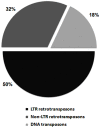A genome-wide survey of genetic instability by transposition in Drosophila hybrids
- PMID: 24586475
- PMCID: PMC3930673
- DOI: 10.1371/journal.pone.0088992
A genome-wide survey of genetic instability by transposition in Drosophila hybrids
Abstract
Hybridization between species is a genomic instability factor involved in increasing mutation rate and new chromosomal rearrangements. Evidence of a relationship between interspecific hybridization and transposable element mobilization has been reported in different organisms, but most studies are usually performed with particular TEs and do not discuss the real effect of hybridization on the whole genome. We have therefore studied whole genome instability of Drosophila interspecific hybrids, looking for the presence of new AFLP markers in hybrids. A high percentage (27-90%) of the instability markers detected corresponds to TEs belonging to classes I and II. Moreover, three transposable elements (Osvaldo, Helena and Galileo) representative of different families, showed an overall increase of transposition rate in hybrids compared to parental species. This research confirms the hypothesis that hybridization induces genomic instability by transposition bursts and suggests that genomic stress by transposition could contribute to a relaxation of mechanisms controlling TEs in the Drosophila genome.
Conflict of interest statement
Figures



References
-
- Arnold M (1997) Evolution through genetic exchange. Oxford University Press.
-
- Arnold M (2006) Natural hybridization and Evolution. Oxford University Press.
-
- Pollock (1988) A morphometric analysis of a Pseudopanax hybrid swarm. University of Auckland.
-
- Rieseberg LH, Raymond O, Rosenthal DM, Lai Z, Livingstone K, et al. (2003) Major ecological transitions in wild sunflowers facilitated by hybridization. Science (80-) 301: 1211–1216 Available: http://www.ncbi.nlm.nih.gov/pubmed/12907807. - PubMed
-
- Nolte AW, Tautz D (2010) Understanding the onset of hybrid speciation. Trends Genet 26: 54–58 Available: http://linkinghub.elsevier.com/retrieve/pii/S0168952509002492. - PubMed
Publication types
MeSH terms
Substances
LinkOut - more resources
Full Text Sources
Other Literature Sources
Molecular Biology Databases

